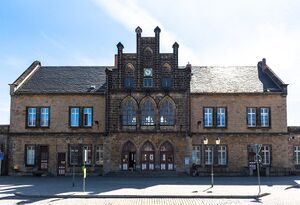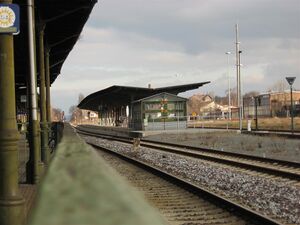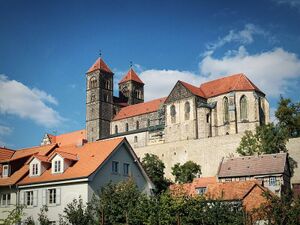Quedlinburg
| Quedlinburg | |||||
|---|---|---|---|---|---|
| Japanese Name | クヴェトリンブルク | ||||
| Weapon | |||||
| Race | Human | ||||
| Nationality | |||||
| Birthday | July 2 | ||||
| Constellation | Cancer | ||||
| Talents | Offensive magic | ||||
| Likes | Stories with a magical theme | ||||
| Dislikes | Tragedy | ||||
| Strengths | Does her best at all times | ||||
| Weaknesses | So absorbed with what she likes that she cannot see her surroundings | ||||
| Hobbies | Writing stories, reading comics | ||||
I'm Quedlinburg of Harz Academy of Magic. Wernigerode and I were classmates at the academy and we've been friends since childhood. I'm rare for a mage in Harz, as I excel at offensive magic. I'm just like Professor Goslar. I will fight for everyone's smile. Please take care of me from now on, Conductor.
Layers
| Icon | Title | Release Date | Where to Obtain |
|---|---|---|---|
| [Dreaming Magic Warrior] Quedlinburg | 2022 November 8 | [Training Camp - Quedlinburg] Event Reward | |
| [Never Give Up on Dreams] Quedlinburg | 2022 November 1 | [Harz and the Dreaming Nightmare] Event Reward | |
| [Turning Thoughts Into Magic] Quedlinburg | 2022 October 31 | [Harz and the Dreaming Nightmare] Limited Gacha |
Skills
Trivia
- Quedlinburg's birthday is the opening date of Quedlinburg station in 1866. Quedlinburg also shares her birthday with Friedrich Gottlieb Klopstock (1724), who is regarded as the founder of modern German poetry.
- Similar to Wernigerode and Goslar, Quedlinburg's magic theme is themed after the Walpurgisnacht and the Harz highlands. In the case of Quedlinburg, the closest castle is the Quedlinburg Abbey, a former house of secular canonesses (Frauenstift) in Quedlinburg in what is now Saxony-Anhalt, Germany.
- Quedlinburg's interest in writing stories is also a reference to Klopstock, whose birthplace is in Quedlinburg.
- The comic strip art in [Turning Thoughts Into Magic] could refer to the artist Lyonel Feininger, who has a dedicated gallery in Quedlinburg. While Feininger was most famous as a member of the German Expressionist school of art, he was also a successful cartoonist.
- The building in the bottom left comic panel of [Turning Thoughts Into Magic] is the Quedlinburg station of Saxony-Anhalt. The train on the top right panel is a steam locomotive 52 8147-2, built in 1942, was placed as a monument by the owner of a hotel at the station on the forecourt directly next to the station precinct on 16 September 1993. Due to major rust damage and a change of ownership of the hotel, the locomotive was auctioned in June 2006.
Counterpart
Quedlinburg station is a station on the Magdeburg–Thale railway in Quedlinburg in the German state of Saxony-Anhalt. The station was opened on 2 July 1862 with the railway line from Halberstadt to Thale. The entrance building and other buildings date from its opening. A number of industrial companies settled in the following years near the railway. In 1885, Quedlinburg became a small railway junction with the opening of the line to Gernrode and Ballenstedt. The railway line to Blankenburg was opened in 1908. The station had to be rebuilt to accommodate the additional trains.
The Gothic Revival entrance building of 1862, together with the other parts of the nearly complete Gründerzeit ensemble, is heritage-protected. Since the conversion of part of the formerly standard-gauge line to Frose in 2006 to create the Quedlinburg–Gernrode section of the metre gauge Selke Valley Railway (Selketalbahn), it has been an interchange station between that line and the standard gauge Halberstadt–Thale railway. From 1908 to 1969, the station was also served by the line to Blankenburg, the so-called Quäke.
Quedlinburg station also played a significant role in times of peace. During the First World War, Quedlinburg Station was used to transport prisoners of war who were being transported to or from the Quedlinburg POW camp on the Ritteranger, two kilometres north of Quedlinburg. The first prisoners arrived in Quedlinburg on 24 September 1914. The railway area was heavily fought over in March 1920 during the Kapp Putsch. Evidence of this is provided by photographs of the bombed station tunnels, although the history of the fighting is not known in detail.
The station has a nearly complete ensemble from the Gründerzeit. It consists of a listed Gothic Revival entrance building from 1862, a locomotive shed from 1862 and 1889/1892, a goods shed, one of the oldest surviving turntables in Germany from 1889, an express freight shed and a toilet block. Furthermore, it includes a water tower of the Schäfer type from 1907/1908, a residence building from 1906, signal boxes from 1907/1908, a toilet block from 1908, a ticket office from 1909 and a water crane from the period around 1955. The interior of the Gothic Revival entrance building has stained glass windows, which were redesigned in 1906. These were produced by the Ferdinand Müller stained glass factory and represent views of the castle hill (Schlossberg) and the town hall (Rathaus). The station has been entered in the list of Quedlinburg cultural monuments. Wikipedia
Quedlinburg Abbey (German: Stift Quedlinburg or Reichsstift Quedlinburg) was a house of secular canonesses (Frauenstift) in Quedlinburg in what is now Saxony-Anhalt, Germany. It was founded in 936 on the initiative of Saint Mathilda, the widow of the East Frankish King Henry the Fowler, as his memorial. For many centuries it and its abbesses enjoyed great prestige and influence. Quedlinburg Abbey was an Imperial Estate and one of the approximately forty self-ruling Imperial Abbeys of the Holy Roman Empire. It was disestablished in 1802/3. The church, known as Stiftskirche St Servatius, is now used by the Lutheran Evangelical Church in Germany. The castle, abbey, church, and surrounding buildings are exceptionally well preserved and are masterpieces of Romanesque architecture. As a result, and because of their historical importance, the buildings were inscribed on the UNESCO World Heritage List in 1994.
Quedlinburg Abbey was founded on the castle hill of Quedlinburg in the present Saxony-Anhalt in 936 by King Otto I, at the request of his mother Queen Mathilda, later canonised as Saint Mathilda, in honour of her late husband, Otto's father, King Henry the Fowler, and as his memorial. Henry was buried here, as was Mathilda herself. The "Kaiserlich freie weltliche Reichsstift Quedlinburg" ("Free secular Imperial abbey of Quedlinburg"), as its full style was until its dissolution in 1802, consisted of a proprietary church of the Imperial family to which was attached a college of secular canonesses (Stiftsdamen), a community of the unmarried daughters of the greater nobility and royalty leading a godly life. The greatest and most prominent foundations of this sort were Essen Abbey, Gandersheim Abbey, Gernrode Abbey, and Herford Abbey, in the last of which the young Queen Mathilda had been brought up by her grandmother, the abbess. Through the efforts of Queen Mathilda, Quedlinburg Abbey became one of the scholastic centers of Western Europe.
Significant renovation work was done in 1863-82. The western towers were rebuilt. The pulpit was also added at that time and the crypt was given a new front. In 1936-9 changes were made to the choir to make it better suited as a Nazi shrine (also see below under burials). The Gothic structure was internally "returned" to Romanesque style. The church was rededicated in 1945 and restoration work on some part of the church has since been ongoing to this day. Wikipedia
Map
Gallery
- Pages using Tabber parser tag
- Pages using DynamicPageList3 parser tag
- Weapon Staff
- Human
- Eisengrad
- Cancer
- Element Blow
- Element Dark
- Element Light
- Element Water
- Train Knights
- Germany
















